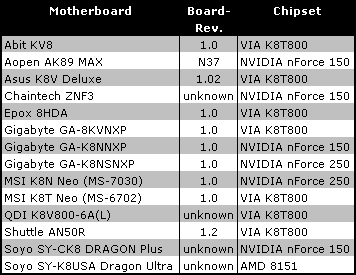THG Puts 13 Bleeding-Edge Memory Modules, 14 Mobos To the Match-Up Test
General Overview Of The Motherboards
Test System
| AMD Processors (Socket 754) | |
|---|---|
| 200 MHz FSB | Athlon 64 3400+ (2200 MHz 128/512 kB) SH7-C0Athlon 64 3400+ (2200 MHz 128/512 kB) SH7-CG |
| Common Hardware | |
| Graphics Card | Asus A9800XT/TVD, Rev. 1.01GPU: ATI Radeon 9800XT, 412 MHz Chip ClockMemory: 256 MB DDR-SDRAM, 365 MHz Chip Clock |
| Hard Drive (AMD System) | FastTrak S150 TX2plus (Bios: 1.00.0.37)2 x SATA Maxtor 6Y080M0 (Raid 0)80 GB / 8 MB Cache / 7200 rpm |
| DVD/CD-ROM | MSI MS-8216 16x DVD |
| Software and Drivers | |
| ATI Graphics | Catalyst Version 04.4 (6.14.10.64.36) |
| NVIDIA Cipsets | V 2.45 |
| VIA Chipsets | V 14.51 |
| DirectX | Version: 9b |
| OS | Windows XP, Build 2600 SP1 (English) |
Test Description
Our approach was conceivably simple: after deleting the CMOS by setting the appropriate jumper, we set the memory in the BIOS to DDR400 and the timing specifications to "Auto".
Then, we booted up Windows XP, where links to Prime 95 and CPU-Z are directly located in the Autostart file, so that both applications are executed immediately during start-up. Approximately seven minutes were required to run "Test 1;" while this was going on we noted the ascertained memory timings.
As the computer had to be switched on and off very frequently, we decided to switch off the computer directly by means of the switch on the mains power supply due to time pressure and to power the hard disks via a different test computer. Eventually, if these were to be switched off and then immediately booted up again no less then 360 times - the wear and tear on such operating samples is correspondingly high.
Get Tom's Hardware's best news and in-depth reviews, straight to your inbox.
Current page: General Overview Of The Motherboards
Prev Page Soyo SY-K8USA Dragon Ultra - AMD 8151 Next Page Test Results
Patrick Schmid was the editor-in-chief for Tom's Hardware from 2005 to 2006. He wrote numerous articles on a wide range of hardware topics, including storage, CPUs, and system builds.
